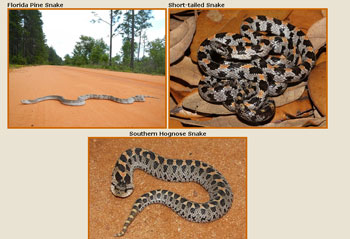Tracking website launched for the southern hognose snake, short-tailed snake, and the Florida pine snake.
For those of you who are herping in Florida, the state's Florida Fish and Wildlife Conservation Commission is seeking your help when sighting certain wild snake species. If you see the southern hognose snake (Heterodon simus), short-tailed snake (Lampropeltis extenuata), and Florida pine snake (Pituophis melanoleucus mugitus) on your herping adventures, or are just outdoors, please report the sightings on the FWC website here.

Florida rare snake registry website
For those of you who are herping in Florida, the state's Florida Fish and Wildlife Conservation Commission is seeking your help when sighting certain wild snake species. If you see the southern hognose snake (Heterodon simus), short-tailed snake (Lampropeltis extenuata), and Florida pine snake (Pituophis melanoleucus mugitus) on your herping adventures, or are just outdoors, please report the sightings on the FWC website here.
The Florida Fish and Wildlife Conservation Commission is enlisting the public's help because the snakes spend most of their time underground and are difficult to survey. The snakes have been petitioned for federal listing as endangered species. Those who see the snakes (dead or alive) are encouraged to photograph the snake for positive identification and to fill out the simple form on the Florida Rare Snake Registry web page. The registry web page has species information as well as descriptions and detailed photos of each snake. The registry enables you to enter your geographical location (lattitude and longitude), date of sighting, and your contact information.
The data will be used to plan future state research projects and will help to determine where each species occur in the state.


